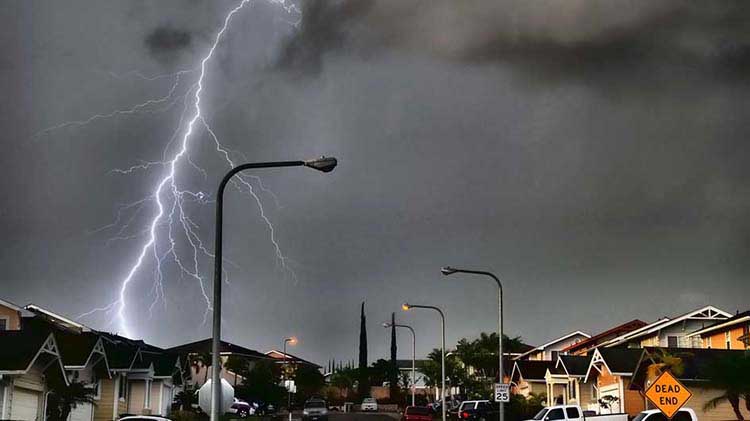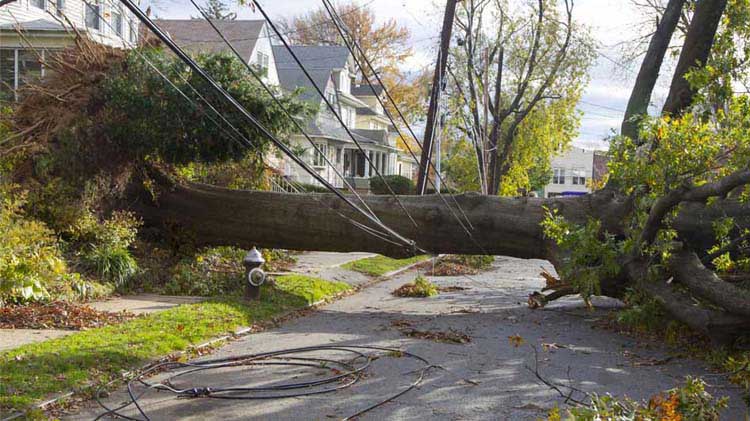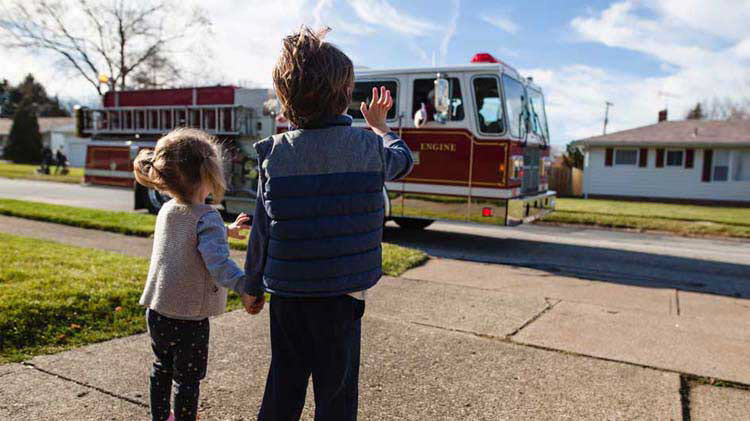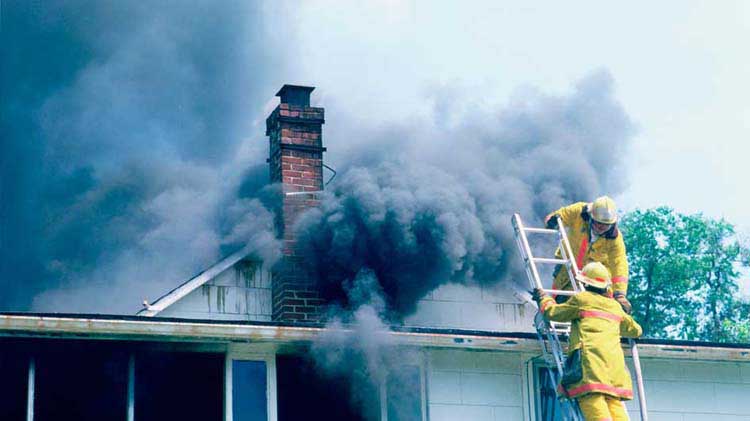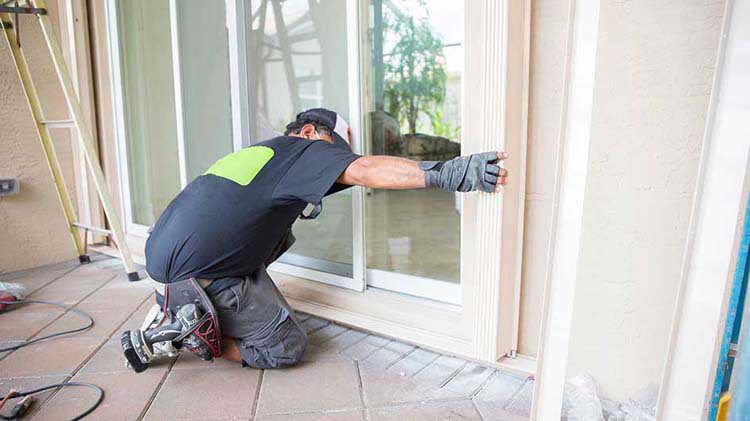Home lightning protection
Help reduce your risk of lightning and surge damage with the following lightning protection tips.
Electricity provides benefits for our homes and electronic devices, but it can also present great risks to consider including lightning strikes and power surges.
Lightning strikes can be dangerous and are a frequently encountered weather hazard in the U.S. Data from State Farm® shows that the average cost for a lightning strike claim in 2023 was over $18,000. State Farm paid over 18,000 lightning-related claims the same year.
A sudden electrical surge can silently damage appliances and an arc fault could spark an electrical fire. In fact, electrical malfunction was the fourth-highest cause of home fires in 2022.
Taking time to review some information and precautions could help protect you and your property.
Lightning facts
The Centers for Disease Control and Prevention (CDC) estimates that lightning strikes the ground, on average, about 40 million times per year in the U.S. According to the Insurance Information Institute, lightning strikes resulted in 13 lightning-related deaths in 2023. The institute also found lightning strikes accounted for over $1.2 billion in insurance claims. Many times, these strikes can land on or near homes, wreaking havoc on their electrical system, appliances or electronics.
Consider safeguarding yourself and your property from lightning-inflicted damage by becoming familiar with the following information.
- Strikes can reach long distances. During a thunderstorm, don't let dry conditions fool you. Lightning can strike up to 10 miles away from an area of rainfall.
- The heat is extreme. A lightning strike can heat the surrounding air as much as 18,000 to 60,000 degrees Fahrenheit.
- Strikes commonly occur on the East Coast. According to the previously referenced CDC article, most lightning strikes in the U.S. happen in Florida and other Gulf Coast states, while Pacific Coast states see the least.
How can lightning strike you?
You don't have to be hit directly by a lightning strike to suffer injuries. You also can be struck by:
- Side flashes — when lightning jumps from its primary target, typically a taller object, to the victim.
- Ground current — when lightning strikes an object, travels across the ground and makes contact with a victim.
- Conduction — when a victim touches a metal surface that’s been struck by lightning.
Potential damage caused by lightning
A typical lightning strike carries around 300 million volts of electricity. That much power can cause serious damage if it connects with a structure. If your home has been struck by lightning, common signs of damage may include:
- Charring — a lightning-strike site is often charred by lightning's intense heat. If you believe your home was struck by lightning, consider inspecting the property for burnt patches and charring.
- Fire — a lightning strike's intensity can also lead to active fires, so look out for any related signs such as smoke, a burnt smell or heat. Check out these tips on fire safety and what to do after a house fire.
- Power outages — a lightning strike can cause power outages, whether from infrastructure damage or short-circuiting. Having an emergency kit on hand — including a flashlight — can be helpful for this situation.
- Damaged electrical switches — similarly, the power surges sometimes caused by lightning can lead to burnt electrical switches. If your home has been struck, consider having a certified electrician inspect switches for damage.
- Roof and wall damage — lightning can damage a roof or wall, even to the point of causing holes or reducing a home’s structural integrity. Keep an eye out for structural damage caused by lightning strikes. If you want to hire a contractor for repairs, consider reading up on ways to avoid contractor fraud before deciding.
- Downed power lines — a heavy storm can knock down power lines. If this happens, avoid approaching or getting near the downed power lines as they may carry live electricity, which is extremely dangerous. Instead, call the utility company and inform them of the downed power line(s) and its location. Lightning can also strike a power line directly, which could spark a fire. If this happens, call 911 and report the fire immediately.
Whole-house surge protection
Power surges can damage property, home infrastructure and potentially cause additional hazards like fires. Because of the dangers they pose, consider familiarizing yourself with ways to help prevent electrical surges.
Where do electrical surges come from?
An electrical surge is a sudden increase in voltage that can damage a home's electrical components. A surge can happen with:
- The source — an electric utility switches power from one area of the grid to another.
- Appliances — air conditioning units, furnaces, refrigerators or vacuum cleaners turn on or off.
- Infrastructure malfunction — electric utility lines touch one another.
- Natural electricity — nearby lightning strikes occur.
Surges can travel down power, telephone and cable TV lines. When there is a surge, unprotected electronics and appliances can be damaged. The damage builds up over time until the appliance components fail. Properly installed surge protection devices (SPDs), combined with a good grounding system, can help protect electronics and appliances from electrical surges. An SPD diverts the surge to the ground around a home where the surge dissipates. It's among the reasons why a good grounding system is important for surge protection.
A step-by-step electrical surge protection plan
- Consider asking a qualified electrician to check your home's grounding system to determine if it's in working order.
- Plug electronics and appliances into point-of-use SPDs. Use single-port SPDs for appliances with a power cord only and multi-port SPDs for appliances with an antenna, cable, telephone and power cords.
- Consider installing a whole-house surge protection system to help absorb larger surges coming from outside the home. This device can be installed on the electrical meter by the utility company, or next to the electric service panel by an electrician.
What is a home lightning protection system?
When lightning strikes, the resulting electrical surge can travel through utility transmission lines to nearby homes. And, of course, a direct lightning strike on a home can cause serious damage. While it’s not intended to prevent a strike, a lightning protection system may provide a safer path for an electrical current to be directed to the ground.
Keep in mind this is not a do-it-yourself project. Only experienced and reputable lightning protection contractors listed by Underwriters Laboratories Solutions (UL Solutions) and certified by the Lightning Protection Institute (LPI), should install these systems. Qualified specialists use UL-listed materials and check that installation methods comply with nationally recognized safety standards of LPI, UL Solutions and the National Fire Protection Association (NFPA) to help protect a home from lightning.
What does a lightning protection system look like?
- Lightning rods — also referred to as air terminals, are copper or aluminum rods vertically mounted on the roof at regular intervals. The air terminals serve as strike receptors, designed to help intercept the lightning strike.
- Main conductors — constructed of aluminum or copper, these braided cables connect the air terminals to other system components and the grounds.
- Grounds — a minimum of two ground rods, driven at least 10 feet deep in the earth, are required for all structures. The ground terminations direct dangerous currents into the ground to help reduce the chance of injury or structural damage.
- Bonds — join metallic bodies (roof components) and grounded building systems to the main conductor to maintain conductivity and help prevent side flashing.
- Surge arresters and suppressors — surge suppressors are installed at the electrical panel(s) to help prevent the entrance of surge spikes which can cause fires. Arresters, installed at electrical panels, help protect heavy appliances and prevent fires at service panel entrances (commonly referred to as breakers or fuse boxes). Additional devices may be needed to help protect other in-house electronics. Surge protection devices are typically installed with a lightning protection system.
- Tree protection — when considering how to help protect your home from lightning, Clemson University's College of Agriculture, Forestry and Life Sciences recommends considering lightning protection systems for trees on your property. An unprotected tree near a structure can also create a side-flash hazard to a nearby home.
These systems should be designed and installed by a qualified lightning protection system contractor.
Lightning insurance
While there isn't a lightning coverage-only policy, if lightning does strike, your homeowners, condo or renters policy may offer coverage for resulting damage. You can also contact your State Farm insurance agent if you have lightning coverage questions. In the case of a covered claim, homeowners insurance and auto policies that carry comprehensive coverage can extend to damages related to, or caused by, lightning. Some policies provide specific details for damage caused by power surges induced by lightning strikes. However, insurance policies aren't a replacement for preparedness; they're an additional way to be prepared.
Lightning safety tips
Here are some tips that may help protect you and your family in case of lightning.
- Get out of the water. If swimming or boating when lightning is present, move to dry land as soon as possible. Water conducts electricity and bodies of water can be hazardous in lightning storms.
- Avoid tall objects. Keep away from utility poles, towers or isolated trees.
- Move inside. Go indoors at the first sign of a storm. An enclosed building offers the best protection.
- Assess vehicles if necessary. If unable to move indoors, and you need to seek shelter in a vehicle, find one with a hard-top. Avoid sitting inside convertible cars, golf carts and motorcycles as they contain exposed metal parts that can conduct electricity.
- Heed weather alerts. If you receive prior indication or warnings of a storm, avoid hazardous areas. Examples include elevated locations, like a hilltop or areas where you’re likely to be the tallest thing there, such as a golf course or open field.
- Avoid electric items. Keep away from electrical appliances, TVs, fireplaces, metal objects, windows or doors.
- Keep away from gas utilities. Avoid touching anything served by gas lines, such as water heaters, ovens, furnaces and fireplaces.
- Avoid water utilities. Stay away from water sources, including pipes, sinks and showers.
- Steer clear of metal. Do not touch metal surfaces, such as a sliding door.
- Stand away from concrete. Do not stand or lean on concrete structures. Metal bars inside the concrete can conduct electricity.
- Contact emergency services. If someone has been struck by lightning, call 911 or your local ambulance service. Give first aid if you are qualified. Lightning victims are safe to touch and require medical attention.
- Be cord conscious. Cordless and cellphones are generally safe to use. If your home has a corded phone, try not to use it unless necessary in case of an emergency.
For additional information on ways to help protect your family and home, or for a list of certified professionals, consider contacting the Lightning Protection Institute or UL Solutions.
